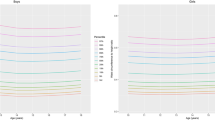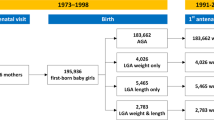Abstract
OBJECTIVE: Syndrome X (clustering of insulin resistance, dyslipidaemia and hypertension) in adults with central obesity has been suggested to be a consequence of poor foetal development. We investigated clustering of syndrome X factors in a sample of 8-y-old Australian children, and whether the clusters were associated with size at birth and childhood obesity.
DESIGN: Longitudinal, 1997 follow-up of children enrolled as singleton-born neonates in 1989.
SUBJECTS: A total of 298 healthy Australian children (208 boys, 90 girls, age range 7.4–8.9 y).
MEASUREMENTS: Anthropometry at birth and at 4 weeks. In 1997, at 8 y of age: fasting insulin and glucose, total and HDL-cholesterol, triglycerides and blood pressure.
RESULTS: Adverse levels of insulin and glucose, cholesterol and triglycerides co-existed more often than expected by chance (P<0.01). Three factors were identified in factor analysis: one loading on systolic and diastolic blood pressure (‘blood pressure’); a second loading on insulin and glucose (‘insulin resistance’); and a third loading negatively on HDL-cholesterol and positively on triglycerides (‘dyslipidaemia’). The blood pressure factor was correlated with fatness at age 8 y (eg fat mass estimated from skin folds, r=0.11) and, after adjustment for current size, with birth weight (r=−0.15). Fat mass was also correlated with both ‘insulin resistance’ (r=0.24) and ‘dyslipidaemia’ (r=0.19). The increase in ‘insulin resistance’ (P=0.03) and ‘dyslipidaemia’ (P<0.01) per category of fat mass was greatest for subjects with higher-than-median subscapular-to-triceps ratio of skin folds. Neither ‘insulin resistance’ nor ‘dyslipidaemia’ was associated with anthropometry at birth.
CONCLUSIONS: The Syndrome X risk variables clustered among children who had a tendency to deposit fat on the trunk. There was no evidence in this sample that infant size predicts development of the insulin resistance or dyslipidaemic components of the syndrome by age 8.
This is a preview of subscription content, access via your institution
Access options
Subscribe to this journal
Receive 12 print issues and online access
$259.00 per year
only $21.58 per issue
Buy this article
- Purchase on Springer Link
- Instant access to full article PDF
Prices may be subject to local taxes which are calculated during checkout


Similar content being viewed by others
References
Reaven GM . Role of insulin resistance in human disease Diabetes 1988 37: 1595–1607.
Zimmet P . Diabetes epidemiology as a tool to trigger diabetes research and care Diabetologia 1999 42: 499–518.
Sakkinen PA, Wahl P, Cushman M, Lewis MR, Tracy RP . Clustering of procoagulation, inflammation and fibrinolysis variables with metabolic factors in insulin resistance syndrome Am J Epidemiol 2000 152: 897–907.
Chen W, Srinivasan S, Elkasabany A, Berenson G . Cardiovascular risk factors clustering features of insulin resistance syndrome (Syndrome X) in a biracial (black–white) population of children, adolescents and young adults Am J Epidemiol 1999 150: 667–674.
Barker D, Hales C, Fall C, Osmond C, Phipps K, Clark P . Type 2 (non-insulin dependent) diabetes mellitus, hypertension and hyperlipidaemia (syndrome X): relation to reduced fetal growth Diabetologia 1993 36: 62–67.
Dwyer T, Ponsonby A-L, Newman N, Gibbons L . Prospective cohort study of prone sleeping position and sudden infant death syndrome Lancet 1991 337: 1244–1247.
D'Espaignet E, Dwyer T, Newman N, Ponsonby A-L, Candy S . The development of a model for predicting infants at high risk of sudden infant death syndrome in Tasmania Paediatr Perinat Epidemiol 1990 4: 422–435.
Tanner JM, Whitehouse RH . Revised standards for tricep and subscapular skinfolds in British children Arch Dis Child 1975 50: 142–145.
Beeby P, Bhutap T, Taylor L . New South Wales population-based birthweight percentile charts J Paediatr Child Health 1996 32: 512–518.
Dwyer T, Blizzard C . Defining obesity in children by biological endpoint rather than population distribution Int J Obes Relat Metab Disord 1996 20: 472–480.
Goran MI, Gower BA, Treuth M, Nagy TR . Prediction of intra-abdominal and subcutaneous abdominal adipose tissue in health pre-pubertal children Int J Obes Relat Metab Disord 1998 22: 549–558.
Assmann G (ed.). Lipid metabolism disorders and coronary heart disease MMV Medizin: Munich 1993.
Mathews D, Hosker J, Rudenski A, Naylor B, Treacher D, Turner D . Homeostasis model assessment: insulin resistance and beta-cell function from fasting glucose and insulin concentrations in man Diabetologia 1985 28: 412–419.
Rosner B . Fundamentals of Biostatistics 3rd edn PWS-Kent: Boston, Mat 1990 pp 228–230.
Bartholomew DJ, Knott M . Latent variable models and factor analysis 2nd edn Arnold: London 1999 pp 41–76 173–180
SAS Institute Inc.. SAS/STAT User's Guide, Version 8 SAS Institute: Cary, NCI 1999 pp 1121–1192.
Dwyer T, Blizzard L, Morley R, Ponsonby A-L . Within pair associations between birth weight and blood pressure at age 8 in twins from a cohort study Br Med J 1999 319: 1325–1329.
Freedman D, Serdula MK, Srinivasan S, Berenson GS . Relation of circumferences and skinfold thicknesses to lipid and insulin concentrations in children and adolescents: the Bogalusa Heart Study Am J Clin Nutr 1999 69: 308–317.
Whincup P, Cook D, Adshead F, Taylor S, Walker M, Papacosta O, Alberti K . Childhood size is more strongly related than size at birth to glucose and insulin levels in 10–11-year-old children Diabetologia 1997 40: 319–326.
Crowther NJ, Cameron N, Trusler J, Gray IP . Association between poor glucose tolerance and rapid post natal weight gain in seven-year-old children Diabetologia 1998 41: 1163–1167.
Bavdekar A, Yajnik C, Fall C, Bapat S, Pandit A, Deshpande V, Bhave S, Kellingray SD . Insulin Resistance Syndrome in 8-year-old Indian children. Small at birth, big at 8 years, or both? Diabetes 1999 48: 2422–2429.
Cowin I, Emmett P . Cholesterol and triglyceride concentrations, birthweight and central obesity in pre-school children Int J Obes Relat Metab Disord 2000 24: 330–339.
Fewtrell MS, Doherty C, Cole TJ, Stafford M, Hales CN, Lucas A . Effects of size at birth, gestational age and early growth in preterm infants on glucose and insulin concentrations at 9–12 years Diabetologia 2000 43: 714–717.
Law CM, Gordon GS, Shiell AW, Barker DJ, Hales CN . Thinness at birth and glucose tolerance in seven-year-old children Diabet Med 1995 12: 24–29.
Miettenen O . Design of the Study Base. In: Theoretical Epidemiology: Principles of Occurrence Research in Medicine John Wiley: New York 1985 pp 46–68.
Rothman KJ . Modern Epidemiology Little, Brown: Boston, MA 1986.
Acknowledgements
This study was funded by the National Health and Medical Research Council of Australia. The Tasmanian Infant Health Survey was funded by the National Health and Medical Research Council of Australia, US National Institutes of Health (grant 001 HD28979-01A1), Tasmanian State Government, Australian Rotary Health Research Fund, Sudden Infant Death Syndrome Research Foundation, National Sudden Infant Death Syndrome Council of Australia, Community Organizations' support programme of the Department of Human Services and Health, Zonta International, Wyeth Pharmaceuticals and Tasmanian Sanatoria After-Care Association. Dr Ponsonby was supported by a National Health and Medical Research Council PHRDC Fellowship. Dr Morley was supported by VicHealth (The Victorian Health Promotion Foundation). We thank the nurses who took blood samples and measured blood pressures and anthropometry, and especially thank the children who participated in the study, their families and the schools that provided facilities.
Author information
Authors and Affiliations
Corresponding author
Additional information
A statistical appendix further detailing the methods used in the factor analysis is a available from the website.Supplementary Information
Supplementary information
Supplementary Information 1
Statistical appendix: factor analysis, a summary of the methods used in the factor analysis of the correlations between Syndrome X risk variables, including a comparison of the factor and principal components solutions (PDF 207 kb)
Rights and permissions
About this article
Cite this article
Dwyer, T., Blizzard, L., Venn, A. et al. Syndrome X in 8-y-old Australian children: stronger associations with current body fatness than with infant size or growth. Int J Obes 26, 1301–1309 (2002). https://doi.org/10.1038/sj.ijo.0802111
Received:
Revised:
Accepted:
Published:
Issue Date:
DOI: https://doi.org/10.1038/sj.ijo.0802111
Keywords
This article is cited by
-
Editorial
Indian Pediatrics (2017)
-
Relationship between elevated triglyceride levels with the increase of HOMA-IR and HOMA-β in healthy children and adolescents with normal weight
European Journal of Pediatrics (2015)
-
Clustering of cardiac risk factors associated with the metabolic syndrome and associations with psychosocial distress in a young Asian Indian population
Journal of Behavioral Medicine (2014)
-
Swedish Child Health Care nurses conceptions of overweight in children: a qualitative study
BMC Family Practice (2012)
-
Construct validity of a continuous metabolic syndrome score in children
Diabetology & Metabolic Syndrome (2010)



